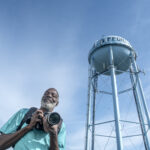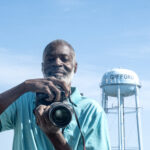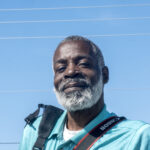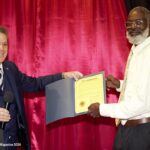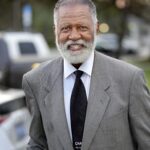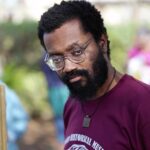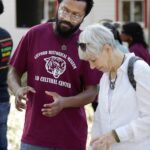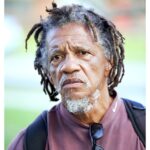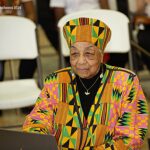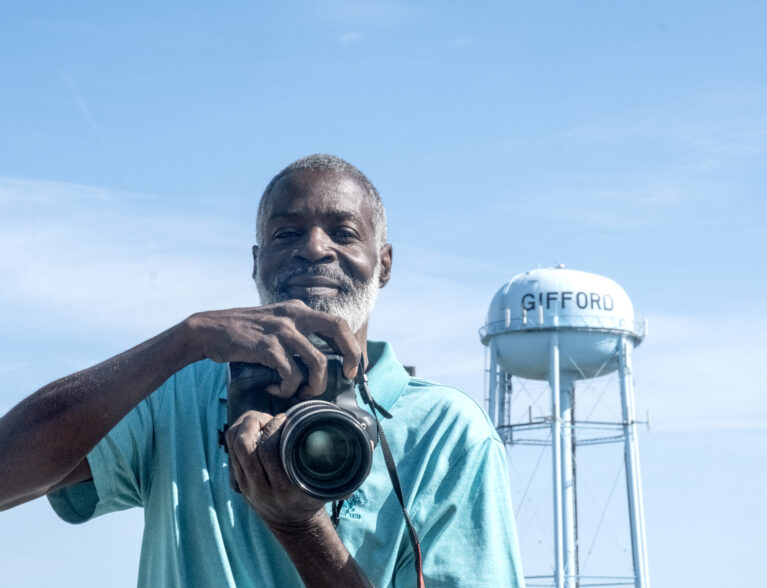
As a young boy growing up in the small, quiet town of Gifford, Ernie Grier had visions of being a doctor treating the sick or even becoming a comedian commanding laughs from the stage.
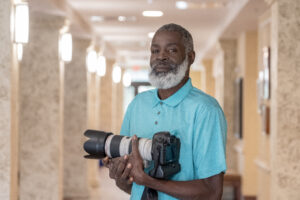
Ernie Grier
PHOTO BY JOSHUA KODIS
But one day his eyes fell on his aunt’s Kodak camera, only to ‘borrow’ it later, gently taking the apparatus apart one curious piece at a time to learn the mystery of how it worked.
Somewhere between snapping pictures and admiring the images that stared back at him, the teen fell in love with his newfound hobby.
“I told my mom I was going to work for The Press Journal,” Grier said, recalling how he – setting aside dreams of working in medicine or crafting jokes – told his mom at age 15 he would instead be a photojournalist at the daily paper.
“My mom told me I always had big ideas.”
Grier kept that vision, and in 1980 at age 25 began working at The Press Journal as a pressman, helping to put the paper together, and as a cameraman and a photographer.
Now, after four decades of documenting life in the front porch community and beyond, Grier, still gripping a camera, was honored in February by the Indian River County Commission for his work, activism and impact.
The commission lauded 68-year-old Grier not only for producing timeless images, but upholding Gifford’s heritage, including his push to get the small town’s name painted on the iconic Gifford Water Tower.
“Ernie got the ball rolling. I met Ernie at a clean up event on 45th Street in February 2021. He pointed to (the tower) and said ‘that should say Gifford,’” said Laura Moss, Indian River County Commissioner. “I’m not sure how long before that he was working on it. I was not the first person he said it to. I started (as commissioner) in November 2020.”
Finding inspiration
As a boy, Grier remained curious. He was an avid reader, flipping through novels and even a medical encyclopedia, soaking in ideas and knowledge. He loved watching cartoons and would often imitate the sounds of helicopter rotors and sirens from ambulances and fire trucks.
Grier’s family moved to Gifford in 1958, a time when the town – with its neighborhood fish fries, lush orange groves, and working class neighbors relaxing under shaded trees – had several booming Black-owned businesses.
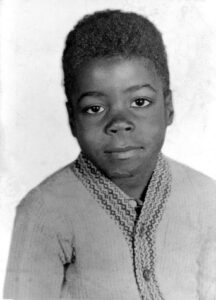
Ernie Grier
PHOTO PROVIDED
Growing up, Grier said he remembered when a bottle of a Coca-Cola drink cost a dime, a Baby Ruth chocolate bar cost a nickel and a loaf of bread cost one dollar.
The photojournalist said his dad worked in transportation for the L.A. Dodgers and would often take Grier and his brother to Historic Dodgertown, now known as the Jackie Robinson Training Complex, to see the players at bat.
“(My dad) drove the Black baseball players to places in Gifford because they couldn’t hang out in Vero,” Grier said. “The Greenleaf Bar was the place to go to in Gifford at that time.”
He found himself inspired by well-known leaders like J. Ralph Lundy, who would become Grier’s boss at The Press Journal. Grier combined his photography with advocacy, creating a mission for the Gifford name to be emblazoned on the water tower that stood in the heart of the unincorporated town.
“Gifford is my hometown. I wouldn’t give it up for nothing,” Grier said.
Grier was hired by Lundy, the widely renowned Gifford activist who had a weekly column in the daily newspaper, started Our Fathers Table Soup Kitchen and was known as “Gifford’s Spokesman.”
Over the years Grier, always inquisitive, would often be the first journalist at the county’s major news stories, including the September 23, 1986 shooting death of Cpl. Richard R. Raczkoski, the first deputy to be slain in Indian River and the subsequent hunt for the killer.
Today, the retired photographer still takes his camera with him everywhere he goes, preserving moments in photographs. But for residents, it’s the tall water tower that is just as much a part of Grier’s legacy.
Gifford Water Tower
Water towers are symbols to the community that give people a sense of place, according to Moss. Gifford’s tower was no different. Moss said Grier was determined to have his hometown’s name painted across the Gifford Water Tower.
“They’re unique. You look up, see the name and you feel proud of your community,” Moss said. “Ernie was very determined in a caring way. It never would’ve happened without him.”
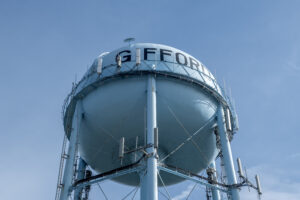
Gifford Water Tower
PHOTO BY JOSHUA KODIS
For Grier, that youthful curiosity he had for reading and taking things apart, came into play.
His determination to have Gifford’s name on the water tower began nearly 50 years ago when he saw the 154-foot tall tower being built. A young Grier – before he worked at the paper – wrote a letter to The Press Journal’s editor, where he addressed county commissioners.
“I asked why can’t Gifford be put on the water tower,” said Grier, who witnessed the tower being constructed in the late 1970s. “I always felt that Gifford was slighted.”
The personal campaign worked.
Gifford’s name was added onto the southwest quadrant of the tower in 2021 at a cost of $6,950, according to Indian River County officials. It was the first water tower for Indian River County Utilities and is one of three owned and operated by the county.
“It looks majestic,” Grier said. “The name finally got put on the water tower. I’m satisfied with that.”
Before Gifford was connected to the county water system, residents had yellow and brown water pouring from their faucets. The water had to be boiled. The filthy water was a health nuisance that plagued the predominantly Black, front-porch town and gained national attention on CBS Evening News in 1977.
“I stopped drinking water back then,” Grier said. “I just started drinking water again a few years ago.”
That push for simple change was among many in a long line of battles to get attention for the town’s concerns. Local leaders from the Progressive Civic League – including Lundy and former NAACP President Victor Hart Sr. – began advocating for Gifford to have clean water. Like Grier’s push for the town’s recognition, community leaders fought for change and respect.
Indian River County later hooked the small town to its water and sewer system, bringing in clean water, in the late ‘70s, according to the Gifford Neighborhood Plan. Leaders also strived for Gifford to have paved streets, streetlights and stop signs.
Today, the landmark tower is operating as a cell phone tower, county officials said.
“They said they’ll leave it up for now,” Grier said.
A pioneer in his own right
Grier, a self-described introvert, said he likes to be behind the camera snapping away. He turns away from the spotlight. But, all eyes were on Grier Jan. 13 as Commissioner Joe Flescher presented him with a proclamation during the Martin Luther King Jr. Banquet held at the Gifford Youth Achievement Center.
“I felt good that night,” Grier said. “I like to get out and take pictures every day. People tell me they appreciate it. I don’t do it for the recognition. I just do it.”
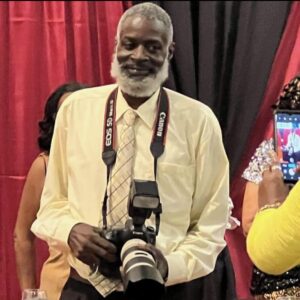
Ernie Grier at the MLK Banquet held on Jan. 13, 2024, at the Gifford Youth Achievement Center.
PHOTO PROVIDED
Then, two days later, Grier hit the streets, taking pictures of marchers during the annual MLK Jr. Parade held on 45th Street. The images – pieces of life found in the community he calls home – can be found on Grier’s self-owned publications The Indian River Times and Gifford Life Magazine pages on Facebook.
Commissioners presented Grier with the proclamation again on Feb. 6 during a board meeting. The commissioners also gave a proclamation to another local pioneer Rev. Carl L. Darrisaw, pastor at Friendship Missionary Baptist Church in Gifford, for his longtime efforts to assist people in the community.
“I’m proud of my community. I’m proud of Indian River County. I’m glad I was born here. I wouldn’t want to be anywhere else,” Grier said to commissioners during the meeting. “What I do is just fun. I’m just out there. If you think I did something special – thank you.”
Leaders described Grier – who served in the Military Police Corps – as lowkey, humble and enormously talented.
“Ernie James Grier exemplifies the true spirit of this honor through his service to our nation, county, and our citizens. As a photographer/photographic journalist, Ernie documented and preserved history for the community,” Flescher said. “Through his lens today, he continues to record life in Gifford, Indian River County in a unique perspective. Future generations will ‘know’ this community because Ernie cared to take the time to photograph.”
On Assignment
A lifelong streak of curiosity also fed his journalistic instincts. Grier remembers listening to the chilling radio call over a police scanner nearly 40 years ago. Sheriff’s Deputy Raczkoski had been shot several times overnight on State Road 60 near 82nd Avenue after responding to a 911 hang up from a Zippy Mart convenience store.
Grier – on assignment for The Press Journal – rushed to the area where several Vero Beach police and sheriff’s deputies were stationed around the scene in the dark. With a long shutter speed, Grier began snapping pictures with his Canon camera of the marked-off, grisly crime site about 3 a.m. on an early Tuesday morning.
“I was the first one to cover it. It was dark and a big scene,” said Grier, who was known to be the first person at breaking news incidents especially during night shifts. “I took a picture of the St. Lucie County sheriff’s helicopter landing on S.R. 60. and (Raczkoski’s) patrol car in front of the phone booth.”
Raczkoski died on the way to the hospital, marking the first line of duty death within Indian River County. The deadly shooting created a devastating loss for the community, sheriff’s officials said.

Indian River County deputies mark off the crime scene area on 28th Avenue where Deputy Garry Chambliss was fatally shot on Feb. 17, 2017, in Gifford. PHOTO PROVIDED BY ERNIE GRIER/ INDIAN RIVER TIMES
The gunman – Vietnam veteran and ex-convict William Reaves – was convicted and sentenced to death row, according to reports. Today, Reaves remains held at the Union Correctional Institution in Raiford, according to the Florida Department of Corrections.
Grier took photos of the aftermath of another shooting on Feb. 17, 2017 that claimed the life of corrections Deputy Garry Chambliss, also known as “Kool-Aid” for his contagious smile. Chambliss, well-beloved in the community, was visiting family in Gifford when he was hit by a stray bullet following a dispute between two people 200 feet from where he was standing.
No arrests have been made in that case.
Looking ahead
Grier, a father of two, said he has no regrets and has lived a good life. The self-taught photographer – who learned how to develop film and use a camera on his own – worked for The Press Journal for 22 years before “retiring.”
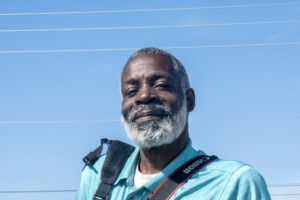
Ernie Grier
PHOTO BY JOSHUA KODIS
“All the things I’ve said I wanted to do, I’ve done them. I don’t let too many obstacles stop me, not even racism,” Grier said, noting that more Black people’s accomplishments need to be told because they have been left out of the history books for centuries. “I hope I live a long time so I can see what’s happening. I’m not dead. I got a lot more to go and a lot more to see.”
Today, Grier still picks up his camera, finding the perfect angle and waiting for the right moment to freeze time, resulting in what many describe as stunning snapshots. For fun, Grier said he likes to go on solo trips, driving to places like Boston, and even Montreal, Canada.
“My camera goes with me everywhere I go,” Grier said.
The soft-spoken photographer isn’t planning on putting the camera down anytime soon. As a youth who once worked in Florida’s citrus groves driving tractors, Grier said he is happy he worked under Lundy’s leadership at the newspaper, and that Lundy set a good example for him.
Grier’s story, however, is far from over. He thinks back to the time he had with his aunt’s camera, unraveling the mystery and the mechanics behind it.
“I’m not responsible for my beginning, not sure when my end will be,” Grier said. “But what I do in the middle to make the world a better place is what will define me.”
- PHOTO BY JOSHUA KODIS
- PHOTO BY JOSHUA KODIS
- PHOTO BY JOSHUA KODIS
- PHOTO BY JOSHUA KODIS
- PHOTO BY JOSHUA KODIS
- PHOTO PROVIDED BY ERNIE GRIER/GIFFORD LIFE MAGAZINE
- PHOTO PROVIDED BY ERNIE GRIER/GIFFORD LIFE MAGAZINE
- PHOTO PROVIDED BY ERNIE GRIER/GIFFORD LIFE MAGAZINE
- PHOTO PROVIDED BY ERNIE GRIER/GIFFORD LIFE MAGAZINE
- PHOTO PROVIDED BY ERNIE GRIER/GIFFORD LIFE MAGAZINE
- PHOTO PROVIDED BY ERNIE GRIER/GIFFORD LIFE MAGAZINE
- PHOTO PROVIDED BY ERNIE GRIER/GIFFORD LIFE MAGAZINE
- PHOTO PROVIDED BY ERNIE GRIER/GIFFORD LIFE MAGAZINE
- PHOTO PROVIDED BY ERNIE GRIER/GIFFORD LIFE MAGAZINE
- PHOTO PROVIDED BY ERNIE GRIER/GIFFORD LIFE MAGAZINE
- PHOTO PROVIDED BY ERNIE GRIER/GIFFORD LIFE MAGAZINE
- PHOTO PROVIDED BY ERNIE GRIER/GIFFORD LIFE MAGAZINE
- PHOTO PROVIDED BY ERNIE GRIER/GIFFORD LIFE MAGAZINE
- PHOTO PROVIDED BY ERNIE GRIER/GIFFORD LIFE MAGAZINE
- PHOTO PROVIDED BY ERNIE GRIER/GIFFORD LIFE MAGAZINE
- PHOTO PROVIDED BY ERNIE GRIER/GIFFORD LIFE MAGAZINE
- PHOTO PROVIDED BY ERNIE GRIER/GIFFORD LIFE MAGAZINE
- PHOTO PROVIDED BY ERNIE GRIER/GIFFORD LIFE MAGAZINE
- PHOTO PROVIDED BY ERNIE GRIER/GIFFORD LIFE MAGAZINE
- PHOTO PROVIDED BY ERNIE GRIER/GIFFORD LIFE MAGAZINE
- PHOTO PROVIDED BY ERNIE GRIER/GIFFORD LIFE MAGAZINE
- PHOTO PROVIDED BY ERNIE GRIER/GIFFORD LIFE MAGAZINE
- PHOTO PROVIDED BY ERNIE GRIER/GIFFORD LIFE MAGAZINE
- PHOTO PROVIDED BY ERNIE GRIER/GIFFORD LIFE MAGAZINE


